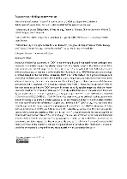Toscana virus – finding the new vectors

Author
Thiesson, Adrien
Arnaud, Frederick
Stejskalová, Markéta
Rehbergerová, Markéta
Kohl, Alain
Ratinier, Maxime
American Society of Tropical Medicine and Hygiene
Publication date
2024Published in
ASTMH Abstract Book 2024Publisher / Publication place
American Society of Tropical Medicine and Hygiene (ASTMH) (New Orleans)Volume / Issue
2024ISBN / ISSN
ISBN: 0-000-00000-0Metadata
Show full item recordCollections
Abstract
Arbovirus Phlebovirus toscanaense (TOSV) is an emerging but still neglected human pathogen that circulates in countries around the Mediterranean Sea. The manifestation of the disease varies from non-symptomatic forms through febrile illness to central nervous system disease. Although, it is one of the leading causes of meningitis and encephalitis, information about TOSV biology and epidemiology is limited. Based on the nucleotide sequences, TOSV is currently divided into 3 genetic lineages A, B and C; but the latter was only described based on partial sequences and virus isolate has never been obtained. Currently, there are only two species of sand flies (Diptera: Phlebotominae), Phlebotomus perniciosus and P. perfiliewi, considered as a proven TOSV vectors. However, the spread of TOSV to the new areas as well as the TOSV detection in several sand fly species suggested that the vector spectrum could be much broader. Here we aim to study in detail the vector competence of four sand fly species (P. tobbi, P. sergenti, P. papatasi, and Sergentomyia schwetzi) to two TOSV strains: 1500590 (TOSV A) and MRS20104319501 (TOSV B). Sand flies were infected by artificial feeding system with blood containing virus and fed females were collected and dissected at days 4, 8 and 14 after infection for virus quantification by infectious viral particles titration and RT-qPCR assay. First, we show that TOSV-B appears to be more successful in development in sand flies than TOSV A. Moreover, P. tobbi with an infection rate of 66% and 53% at D4 and D8, respectively, seems to be the most susceptible species with a weak gut barrier to infection. In contrary, P. sergenti seems to be less susceptible to TOSV B with an infection rate of 5.5%, even though the virus disseminated in the head of all infected females. Additionally, P. papatasi and S. schwetzi appear to be refractory to TOSV B strain infection. In conclusion, our data suggest that two more sand fly species (P. tobbi and P. sergenti) are potential vectors of TOSV. In the context of climate changes and human activities, this information is crucial as sand flies are expected to expand to new areas, together with pathogens they carry.
Keywords
arbovirus, Phlebovirus toscanaense (TOSV), sand flies, infection
Permanent link
https://hdl.handle.net/20.500.14178/2760License
Full text of this result is licensed under: Creative Commons Uveďte původ 4.0 International




